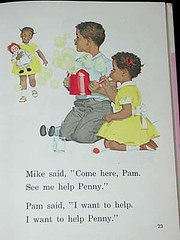Positive deviance and DC Public Schools

The New Guess Who, 1965. Sally, Dick, and Jane ~ Junior Primer Integrated 1st Grade Book.
I have written before about an article from the May 2005 issue of the Harvard Business Review, entitled "Your Company's Secret Change Agents." Alas, this article isn't online for free, but it's worth tracking down and reading. It states that:
within every organization there are a few individuals who find unique ways to look at problems that seem impossible to solve. Although these change agents start out with the same tools and access to resources as their peers, they are able to see solutions where others do not. They find a way to bridge the divide between what is happening and what is possible.
One of the examples in the article is about a set of schools in a Brazilian state. Some of the schools actually out-performed the entire nation, while most of the schools within the same state, with the same resources, underperformed that nation as a whole.
In looking at why these schools succeeded, they discovered that the innovation of these schools was the creation of a "family learning contract" to bind the entire family to the success of the child.
I have written about family learning contracts, First Day activities, linking schools and libraries, and other aspects of creating a "community of learning," something that the "Master Education Planning" process of the DC Public Schools system and the Library Planning Process of the DC Library System, doesn't seem to be doing. Links to these efforts are in the section of Education links in the right sidebar.
Today's Post has a big article about the increased interest in K-12 education issues on the part of the city's residents, "Education Becoming Top Issue For D.C."-- although I would say that creating a "community committed to learning" needs to be concerned about pre-K education issues, as well as undergraduate, graduate, and lifelong learning just as much as K-12 issues.
The fact is that DC has some high-performing schools, such as:
-- Oyster Bilingual Elementary School;
-- Capitol Hill Cluster Schools (Watkins, Peabody, Stuart-Hobson Middle School);
-- Woodrow Wilson High School; and
-- Benjamin Banneker High School;
among others.
The positive deviance approach would say, how can the principles that led to the creation, implementation, and success of these schools be duplicated in other school settings across the city.
I have suggested for some time to either or both:
(1) expand the Capitol Hill Cluster Schools with a school on the north and a school on the south; and
(2) create an arts cluster of schools in the area north of Stanton Park-Maryland Avenue to complement the "arts district" developing on the eastern end of H Street. The schools could be devoted to performing, visual, English language, media, Foreign language and cultural arts. Schools could have artists in residence, living on the campus. Each school could focus on a particular "foreign" language and culture to complement English language instruction in the same way that Oyster does this in Spanish -- but imagine such languages including Chinese, Japanese, Russian, Arabic, German, etc.
There's been hardly any traction wrt these ideas.
And most of the parental activists appear to me to have been merely advocating for more money. The amount of money isn't the problem, although maybe how the money is used is a problem. But clearly, the lack of a culture focused on results is one of the problems. And so is the failure to have a broader community involved and committed to quality education, both generally, and specifically for their children.
I will never forget receiving a call from a social worker at a school south of Hechinger Mall in northeast DC. She was looking for donations of alarm clocks because the students at her school didn't have a reliable parent or guardian to wake them up in the morning, to ensure that the student would get to school on time.
We have an opportunity to do great things.
Or an opportunity to do more of the same, but somehow expecting different results.
I'm not too hopeful.
The HBR article suggests this process for creating organizational change:
Step 1: Make the group the guru. The members of the community are engaged in the process of their own evolution.
Step 2: Reframe through facts. Entails restating the problem in a way that opens minds to new possibilities.
Step 3: Make it safe to learn. Involves creating an environment that supports innovative ideas.
Step 4: Make the problem concrete. The community combats abstraction by stating uncomfortable truths.
Step 5: Leverage social proof. The community looks to the larger society for examples of solutions that have worked in parallel situations.
Step 6: Confound the immune system response. Solutions are introduced organically from within the group in a way that promotes acceptance.
"The positive-deviance approach has unearthed solutions to such complicated and diverse problems as malnutrition in Mali and human trafficking in East Java. This mehodology can help solve even the most extreme dilemmas."
I used to be a big fan of charter schools, because (and I still think this way) I think it is unfair to hold students hostage to a system that isn't working to achieve excellence. But privatizing the public education function (have you ever talked to a 24 year old recent college graduate proudly discussing how she is writing a charter school's curriculum?, while you are wondering, "what about best practices?"--why do you need to write a fresh-from-scratch curriculum when clearly there are extant excellent examples?) is hardly the solution to stabilizing neighborhoods and creating a great public school system.
Today, we could probably take all our kids and teachers and put them in the Montgomery County Schools, and at the same time put the MoCo students and teachers in the DCPS schools, and DC would have great schools and MoCo wouldn't.
Think about that.
Labels: education



0 Comments:
Post a Comment
<< Home